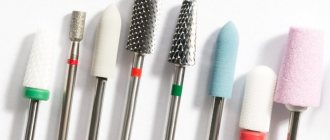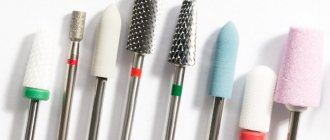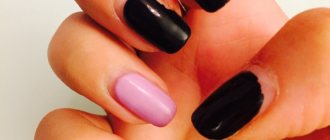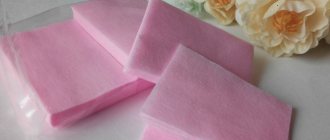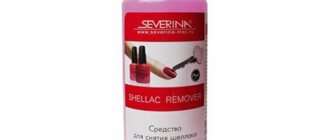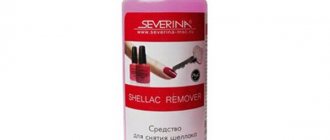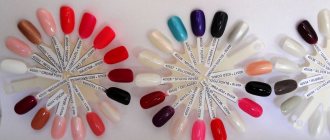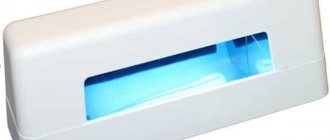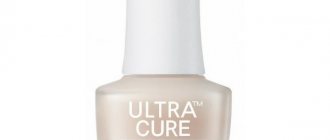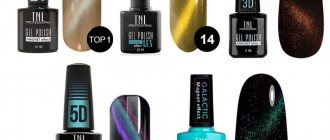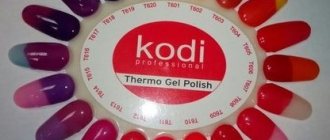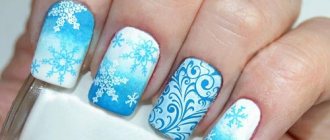The cutter for removing gel polish can be spherical, cone-shaped, metal, ceramic and other types. Each of them has an individual purpose, but they are all needed to perform a high-quality manicure.
The technique of removing decorative coating involves making light, stroking movements from the cuticle to the end of the nail. The middle of the nail is treated with wide nozzles, the sides of the plate with narrow ones. Silicone tips are used only for polishing the surface of the nail (base layer) before applying a new layer of gel polish or shellac.
The cost of cutters is variable, ranging from 150-450 rubles and depends on the materials, shapes, sizes and reputation of the manufacturer.
What is a cutter for removing gel polish?
A cutter for removing gel polish is a rotating tool that is equipped with a sharp tip. It works in a machine that is designed to perform standard hardware manicure. The cutter changes depending on the tasks assigned (it is available with different notches and degrees of abrasiveness), and rotates at high speed.
If an experienced professional uses the machine, then it takes a minimum of time to remove gel polish with a cutter - no more than 15 minutes for both hands. The procedure cannot be carried out in this way if:
- severe dystrophy and excessive sensitivity of the nail plates;
- existing allergy to dust in the master or female client.
Another disadvantage of using a cutter to remove gel polish is the high cost of the machine for hardware manicure and the actual rotating attachments, and using cheap equipment for this manipulation is strictly not recommended.
What is a cutter and what is its purpose?
Today, hardware manicure is very common; it quickly occupied its niche, completely eliminating its competitor, when the nails were simply soaked in water. Unlike its predecessor, this method allows you to quickly and easily prepare your nails for gel polish coating. Due to the fact that the cutter rotates at the same frequency all the time, this allows the surface of the nail to be made uniform and the cuticle to be easily removed. In addition, the cutter attachments rotate very quickly, so you get a manicure without cuts, bleeding or wounds.
The same machine is used to remove the old gel polish coating, only a different cutter is installed. Preparing nails for a new manicure is carried out using this device. Which attachment should I use to remove gel polish on the device? More on this later. To make this procedure easy, you need a cutter with notches or small indentations. This way you can cut off the coating carefully.
What are the advantages of removing gel polish with a machine?
The advantages of removing gel polish with a device include:
- maintaining the density and structure of the nail plate - gel polish removers dry out the nails greatly, which leads to their rapid delamination;
- no contact of the cutter with the surface of the nail, so damage is excluded;
- complete preservation of the base layer of the coating, which prevents the negative impact of external factors on the nail.
The main advantage of the method is the refusal to use removers, which aggressively affect not only the gel polish, but also directly on the natural nail plate. Experts say that thinning, separation and brittleness of nails after a manicure with gel polish do not appear after the use of such specific materials for decorative coating, but against the background of the use of liquids to remove it.
Adviсe
What is the best cutter to remove gel polish? Hardware manicure is safer and non-traumatic compared to filing with a file or removing the gel with acetone. The last two methods are already outdated, and because of them, the nails will become brittle and begin to peel. It is very easy to damage the nail and the skin around it with a file, abrasions form, and it is undesirable to cover such a nail plate with gel.
If you soak the nail, you can dry out the cuticle and nail plate, which will lead to it breaking and causing unpleasant pinching during the procedure. After the nail is soaked, the coating must be removed with a metal spatula, which can injure the surface of the nail, which affects its quality. The procedure for removing gel polish with a manicure machine saves time and does not harm your nails.
The attachment is similar to a corn cob; it fits onto the tool and is firmly fixed. The difference between a cutter may lie not only in the design, but also in the material from which it is made.
What types of machines are there for removing gel polish and shellac?
Depending on the purpose for which the machine for removing gel polish and shellac will be used, you can purchase home or professional equipment. The first option has the following characteristics:
- compact dimensions;
- low power;
- minimum set of cutters (no more than 10 pieces);
- The quality of the attachments is average.
It will be problematic to quickly and efficiently remove gel polish or shellac with home machines, because their cutters wear out a lot.
Professional gel polish remover machines have:
- high power;
- automatic tip ventilation;
- reverse and direct rotation of cutters;
- a large set of attachments (more than 10 pieces);
- the ability to work in different modes and independently adjust the speed of rotation of the nozzle.
It is professional equipment that allows you to work in “emergency” mode and cope with any type of decorative coating.
Watch this video about which manicure machine to choose:
Are there any for left-handed people?
For left-handers, manufacturers introduce special cone-shaped or cylindrical cutters, which are distinguished by a cross cut. Carbide cutters are optimal for left-handers - they are universal and work equally effectively in both forward and reverse rotation.
If it is necessary to treat areas of the lateral skin folds and cuticles, left-handed people will benefit from streamlined ceramic attachments.
Disadvantages of removing the coating with a machine
The only disadvantage of hardware removal is the small shavings or dust that is produced after cutting. This can cause discomfort as you have to breathe in it. It is recommended to wear a mask when working.
Another drawback is the high cost of purchasing this device, which will also require sets with cutters. There should be several sets. Also, all parts of the machine must be kept clean. Nozzles also need to be changed on time, if necessary.
Which cutter to remove gel polish with, their main types
You can remove gel polish with different cutters; masters distinguish three main types of them, which differ in shape:
- Globular . Used for processing cuticles, the diameter ranges from 1-2-3 mm. A spherical cutter ideally processes the cuticle and the nail near it; it can also be used to level the surface of the plate and get rid of tubercles and roughness. Disadvantages of this type of attachment: it cannot be used to remove gel polish from the entire nail; if you press hard while working, it is easy to make a cut.
- Kidney-shaped . Used to treat the nail plate and lateral skin folds, remove pterygium and cuticle. This type of cutter has three subtypes - “flame” (used exclusively for removing the cuticle and removing pterygium), “willow” (allows you to easily process the nail folds), and “lentil” (rough skin near the nail folds is processed). You can remove gel polish with a kidney-shaped cutter, but only with the lower part of the nozzle.
- Conical . It can be truncated, regular, with a rounded end, or needle-shaped. All varieties are suitable for removing gel polish; they also allow the master to level the surface of the nail plate and correct its shape. A conical cutter makes it possible to treat ingrown nails.
Ceramic
A ceramic cutter has several notches of different depths, can be soft, medium and hard, and is available in oval and/or cylindrical shapes. Advantages of using this type of gel polish remover:
- long service life - they can work 3-4 times longer than all others;
- low vibration - there are no shavings during sawing, only the smallest dust is formed, there is no discomfort for the master and the client;
- minimal heating of the plate - you can remove the decorative coating without braking or reducing speed.
The rotation speed is 20 thousand revolutions per minute, the service life of one cutter with maximum active use is 2 months, and these parameters compensate for the high cost of the nozzle.
Metal, steel
Metal cutters are made of tungsten or carbide, but they are never used to remove gel polish. These cutters are suitable for processing rough cuticles and pterygium when performing pedicures. Advantages of a metal cutter:
- effective against calluses (relevant for pedicures);
- do not corrode even with active use;
- respond adequately to disinfection even with aggressive agents;
- remove a layer of 1 mm in one pass over the problem area.
The only drawback of a metal cutter is the high risk of exceeding the permissible rotation speed of the product. Service life is six months, maximum speed is 15 thousand per minute.
Carbide
A carbide cutter is made of metal and has several notches on its surface - their depth depends on the hardness of the nozzle. Notches can be straight, oblique and spiral. "Pros" of using a carbide cutter:
- The hardest layer of gel polish is quickly and efficiently removed;
- makes it possible to make recesses for installing rhinestones;
- effectively files the end of the nail.
The technician must carefully monitor the speed of the nozzle in the device, because exceeding the permissible values increases the likelihood of injury to the nail plate and skin significantly. The service life of the carbide nozzle is a maximum of 4 months, the rotation speed is no more than 15 thousand revolutions per minute.
Diamond
Such cutters have a base on which diamond coating is applied with microparticles - the larger they are, the harder the attachment will be. There are two subtypes of diamond cutters:
- sintered - diamond shavings are applied to the base of the nozzle and then baked in an oven, resulting in a solid tool that has a long service life;
- monolithic - diamond particles are applied to the base using glue in several rows and only after that the tool is placed in the oven, a round-shaped attachment is obtained.
The advantages of using diamond cutters include:
- the ability to remove not only gel polish, but also acrylic decorative coating;
- optimal for cleaning side rollers;
- There are different shapes and sizes of diamond bits available in the market.
The only drawback of a diamond-coated cutter is the need for frequent and thorough cleaning, because the notches are heavily contaminated with dust from gel polish/acrylic/shellac. Rotation speed – maximum 26 revolutions per minute (minimum 18), cutter service life – no more than 4 months.
Cotton or silicone
Such attachments are optimal for beginners - they are soft and can be used for delicate treatment of the nail plate. You won't be able to remove gel polish or shellac with a cotton or silicone attachment, but you can use them to properly treat the surface of the nail and get rid of roughness, bumps, stripes and any irregularities.
Cutters of this type can be spherical or cone-shaped. Experienced professionals recommend purchasing several types of silicone and cotton attachments at once.
Corundum
Made from a synthetic material resembling ceramic chips. A distinctive feature of a corundum cutter is that it does not overheat during operation, which significantly reduces the likelihood of injury to the skin and nail plate. Such attachments are available with coarse and fine abrasive surfaces - the former are necessary for treating wide areas of nails, the latter for cleaning rollers and cuticles.
Advantages of using corundum cutters when removing gel polish:
- You can carefully treat even thin cuticles;
- multifunctionality - you can remove the decorative coating and clean the skin around the nail;
- high strength of the nozzle - does not deform even at high temperatures;
- the material is classified as hypoallergenic.
The disadvantage of the corundum nozzle is the need for frequent washing, since the notches on the surface are tightly clogged with dust from the sawed-off gel polish. Small cutters (with low abrasiveness) are used at a speed of 26 thousand per minute, medium and large (with high abrasiveness) - 12 thousand per minute. Service life under active loads is 3 months maximum.
Corn
Corn is a cutter with many notches over the entire surface. It can be made of ceramics; there are also carbide tips of this type. This type of cutter quickly and efficiently removes gel polish and shellac of any hardness, but can also be used for processing the nail plate (leveling), stripping the cuticle and skin side ridges.
The cutter has a streamlined shape, and if the coating is finely abrasive, then it can process both the cuticle and skin ridges, but at a speed of no more than 15 thousand per minute.
Green and other colors
It is important to know other parameters of the nozzles, which differ in color:
- green;
- yellow;
- red;
- blue;
- black.
The darker the color, the harder the cutter and the higher the abrasiveness of its surface. For example, black will be the hardest, but green will be universal, its hardness/abrasiveness indicator is average. When choosing, professionals recommend paying attention to the labeling of a specific manufacturer, because their indicators may differ.
The color does not mean the entire cutter, but the strip located directly at the nozzle, at its wide edge, on the rod.
Watch this video about the types and purposes of manicure cutters:
Why do cutters need colored notches?
The purpose of the cutter will also be indicated to you by the colored notch in the form of a rim at the base of the tip.
It tells us the rigidity and depends on the cutting of the cutter. The rule is very simple: the darker the color, the harder the cutter is: 1. Black
color indicates the coarsest cut and the highest hardness. This means that this attachment is only suitable for working with extended nails.
2. Cutters with green
strips are coarsely cut and are needed to remove old artificial material.
3. Blue
The rim tells us about the medium degree of hardness. They can already be used on the skin around the perimeter of the nail plate.
4. Red
the color of the notch is already a fine cut. This cutter is suitable for both skin and nail surfaces.
5. Yellow
The cutter is very soft. It can be used on thin skin and on natural nails.
6. Nozzles with white
rims have the lowest degree of rigidity, so they are chosen for skin with increased sensitivity and meticulous work on the nail itself.
How to remove gel polish with a manicure machine: technique
To avoid damage to the nails when removing gel polish with a manicure machine, the manipulation technique must “obey” the following rules:
- The master's elbow must be securely fixed. It is better to rest it on the table/work surface, then the risk of the cutter slipping off the nail is eliminated.
- Remove the gel polish with gentle smooth movements, stroking - first the nozzle approaches the nail, then it is removed. This technique significantly reduces the likelihood of plate overheating.
- The process of removing the decorative coating begins from the middle of the nail, movements are performed slowly. When processing the outer sides of the nail, the movements should imitate sawing.
- The router is never held strictly vertically; it is slightly tilted for safe operation. You should work not with the tip of the nozzle, but with its middle part.
- All movements are performed strictly according to the movement of the cutter. Otherwise, the tool may slip off the nail plate, and this leads to chips of the base and cuts.
- You cannot use manicure attachments as a cutter for removing gel polish, as well as vice versa. Each tool is used for its intended purpose.
- Rhinestones can be cut only with a diamond-coated cutter.
- If the gel polish is removed with a ceramic tool, the technician must wear a mask - this will protect the respiratory tract from the penetration of the smallest dust particles.
- As soon as the layer of decorative coating is removed and the base becomes clearly visible, work with hard cutters should be stopped. The next stage is grinding and polishing the plate with a silicone or cotton nozzle.
Watch this video on how to remove gel polish with a machine:
Which cutter to use for manicure
For manicure, without removing gel polish, you can use the following types of cutter attachments:
- ceramic – you can work with hard nails and cuticles;
- diamond – remove pterygium (a thin layer of skin on the nail near the cuticle);
- metal – excellent for cleaning side rollers;
- silicone, cotton, combined - can be used from the beginning to the end of the process.
The craftsman should have a wide variety of cutters; their various shapes are also useful - cone/reverse cone, needle/ball, bur.
Nozzle materials
Before determining which cutter to dry cuticles with, you need to consider the purpose of the treatment. The nozzles also differ in the material they are made of. They are divided into:
- Silicon and ceramic. These are the cheapest cutters. They are available in professional and home devices. The attachments have different abrasiveness and are suitable for working with rough finger surfaces and shaping nails. The products are also used to treat delicate areas.
- Diamond. Used for delicate treatment where a targeted effect is required, for example, in the area of the nail sinuses and pterygium. Such nozzles are among the most expensive, but they have a high degree of wear resistance. They are usually included with professional devices. In home devices, if there are such cutters, they have a rounded or beveled tip. This is due to security requirements.
- Silicone. They are used for grinding and polishing nails. They wear out quickly, but are also inexpensive.
Which cutter is used to lift the cuticle and remove pterygium from all of the above? Ceramic and diamond cutters are suitable for removing cuticles. The choice of nozzle depends on the hardness and thickness. Ceramic cutters are ideal for fleshy and rough cuticles.
For thin cuticles, it is better to use a fine-grained and diamond nozzle. In any situation, you need to have 2 options of cutters - ceramic or silicon to quickly eliminate keratinization. Diamonds perform excellent correction.
When you are just starting to learn hardware manicure, you should learn how to work with elementary cutters used in processing. Then you may need more complex attachments to perform various nail processing operations.
How to remove gel polish with a machine yourself at home
You should remove gel polish yourself at home using a device according to a clear algorithm:
- Remove topcoat and decorative/color coating. The movements are performed long, longitudinally, in the direction from the cuticle to the end of the nail. The speed is optimal, only the middle part of the plate is processed, the middle part of the cutter is used in the work (the most convex part - the “belly”).
- Move to the side parts of the nail and remove the gel polish here with the tip of the cutter. The rotation speed of the tool does not decrease; you need to monitor the pressure - it should be uniform, without applying any effort.
- The end of the nail (free edge) is processed with the middle of the cutter; it should not be positioned vertically in relation to the plate, but at an angle of 10-15 degrees. This completes part of the work of removing the decorative coating.
- Clean the base layer with a cone-shaped corundum cutter. The speed should be reduced to 10 thousand per minute.
- The final stage is to walk over the surface of the plate with a buffer with an abrasiveness of 240 grit without applying any effort (without pressure).
Watch this video on how to remove gel polish with a machine at home:
Safety rules when using the device
To properly remove gel polish with a special manicure device, it is important to adhere to the rules for using the equipment:
- It is strictly forbidden to use the device “in weight”.
- Both hands should be on the table surface.
- The cutter should move along the nail with short and soft movements, remaining on the plate for no more than 3 seconds. Otherwise, the attachment may cut into the nail.
- It is important to ensure that the device is parallel to the table surface at all times.
- It is necessary to clearly control the force of pressing the cutter on the plate. You can rely on your pressure on the pen as you write.
- The nozzle of the device must be constantly in motion - otherwise a strong burning sensation may be felt on the nail.
An equally important factor is the hygienic disinfection of hands and equipment before starting work. First, soak your hands in a bath of warm water for a few minutes, then dry thoroughly and disinfect with an antiseptic. After this, treat the cutter itself with the solution - for greater efficiency, it is better to soak the attachment for a while in a disinfectant.
How to remove a cutter from a manicure machine
The cutter is removed from the manicure apparatus using different methods, which differ depending on the type of attachment clamp in the apparatus.
Manual clamp
Typical for cheap equipment intended for home use without active use. The mechanism consists of a button and a washer. To remove the cutter, you need to press the button (it is located on the handle body) and unscrew the washer - the attachment will easily come out. To install a new one, you need to press the button again, insert the desired tool and tighten the washer.
The manual clamp is not intended for frequent use; if you constantly change attachments, the equipment will simply break.
Semi-automatic clamping
A special feature of this type of fastening is the presence of a collet, which is a split sleeve (the nozzle is clamped in it). In order to remove the cutter, you need:
- Make a half turn with the ring (upper part of the handle) until a characteristic click appears.
- Remove the cutter without changing the position of the ring.
If you need to insert a new nozzle, then to clamp it you need to turn the ring half a turn in a counterclockwise direction.
Semi-automatic clamps are the most common in manicure machines.
Automatic clamp
The nozzle is clamped in its working position automatically when the device is turned on, so to remove the cutter you just need to disconnect the equipment from the power supply and pull the cutter towards you.
This clamp provides the easiest way to change manicure attachments and get rid of decorative coatings such as gel polish or shellac. It is installed on expensive equipment.
Watch this video on how to insert a router bit into the router handle:
Auxiliary tool for removing gel polish
It is quite possible to remove gel polish only with a cutter, but to carry out the entire manipulation efficiently and properly prepare the nail plate for applying a new decorative coating, you will need other tools:
- orange stick – cleans the inner surface of the nail, moves the cuticle, removes too thin cuticles;
- nail scissors - cut the cuticle and side skin ridges (if they are especially rough);
- metal spatula - pushes back the cuticle, cleans the subungual space from dirt, cleanses the pterygium.
It is highly desirable that the master’s workbench is equipped with an extractor/vacuum cleaner - when removing gel polish with cutters, a lot of dust is generated, which can cause coughing, shortness of breath and allergies. Its instant removal is a comfort for both the master and the client.
At what speed should you remove gel polish with the machine?
It is imperative to monitor the speed when removing gel polish with the device: 12 thousand revolutions per minute is considered optimal for ceramic attachments, and 20 thousand per minute for carbide, metal and others. Professionals recommend using a speed of 30-40 thousand revolutions per minute, which will prevent the nail plate from heating up.
Beginners can stop at 30 thousand revolutions per minute to avoid damaging the client's nail plate or skin.
Nozzle shape
Tools for hardware manicure (pedicure) differ in form:
- Flame - used to remove cracks and rough lateral ridges.
- The needle attachment is designed to lift the cuticle in order to clean the pterygium underneath and remove the dried part. Craftsmen also use a needle head to process side rollers.
- The ball is an indispensable assistant for removing excess skin, as well as for treating rough, hard-to-reach areas.
- Cylinder - an attachment necessary for correcting the nail plate in shape and length.
- Rounded cylinder – levels and polishes the surface of the nail plate.
- Corn - used to form an artificial nail, as well as to remove acrylic and gel polish.
Experienced masters have a full set of manicure tools, since for a high-quality and effective result it is necessary to select suitable attachments. Based on reviews from manicure professionals, a rating of the best brands was compiled.
How to clean a cutter from gel polish
You need to clean the cutter from gel polish after each use; the process is performed in the following order:
- Wipe the attachments with a napkin or small brush to remove dust and skin flakes. This is done “dry”, without the use of water or any antiseptic solutions.
- Disinfect cutters with special solutions Estilodez, Gigasept, Optimax. They are certified, contain anti-corrosion additives, and have antimicrobial, antiviral and antibacterial effects.
- Wash the cutters in a solution with detergent. Dry with cloth or thick paper napkins by blotting.
- Sterilize the attachments. This can be done in an autoclave, glasperlene apparatus or dry-heat oven, but these options are only suitable for salons. At home, you can use the oven as a sterilizer, after first cleaning it of grease and dirt.
The cutters are kept in disinfectant solutions for no more than 20 minutes. When sterilizing in the oven, the attachments are laid out on a baking sheet covered with foil. The oven is heated to 180-200 degrees, the holding time of the attachments is 20 minutes, after which everything is turned off, and the cutters remain in the oven for another 20 minutes.
For home processing of attachments, you can use special craft bags: the instrument is placed in them, they are sealed, and only after that they are sent for sterilization. There is a strip on the surface of the craft bag that changes color at a certain temperature - this indicates the sterility of the cutters.
How to choose a gel polish remover
When choosing a gel polish remover, you need to consider the following nuances:
- weight of the device - 100-200 g is considered optimal, which makes the handle of the router almost weightless and greatly facilitates the work of the master;
- vibration level - the lower it is, the less the master’s hand will get tired, the less noise there will be from the equipment;
- number of revolutions (power) – 30-35 thousand per minute is considered optimal;
- type of cutter clamp - can be manual (suitable for home use), automatic and semi-automatic;
- a set of attachments - a novice master can use a minimal set, an experienced one will probably buy them individually, focusing on his own needs.
Cost of cutters
The cost of cutters depends on the material from which they are made, the “name” of the manufacturer and retail outlet, but the average values are as follows:
- diamond cylindrical with a round tip – 150 rubles;
- ceramic type “corn” with a blue stripe – 450 rubles;
- silicone polishing – 150 rubles (size 15 mm);
- carbide “needle” – 200 rubles;
- “corn” carbide with red or blue markings – 300 rubles;
- felt (cotton) nozzles, set of 6 pieces – 200 rubles.
We recommend reading about what you need to know when choosing a gel polish lamp. From the article you will learn why you need a lamp for gel polish, how it works, and how to choose a lamp for drying gel polish. And here is more information about how to remove shellac at home.
Removing gel polish with cutters is considered a safe, quick way to remove decorative coating before a new manicure. A competent choice of attachments and the correct technique for performing manipulations allow even beginners in the nail industry to do a high-quality manicure. And subsequent disinfection of the cutters and their sterilization makes the process safe even when serving numerous clients.
Ceramic cutter
Nowadays modern manicurists use a ceramic cutter. After using it, the coating turns into dust, not into shavings, it is removed more softly, and there are no unpleasant vibrations that occur when the nail and the cutter come into contact.
Softer texture and high strength are the main advantages of ceramic cutter. One such tool is equivalent to 4 of the same, but made of hard alloy. The coating can be removed easily and quickly due to the fact that the ceramic nozzle does not heat up. How to properly remove gel polish with a cutter? The technology of cutting with a ceramic cutter consists of soft movements that are performed without pressure.
